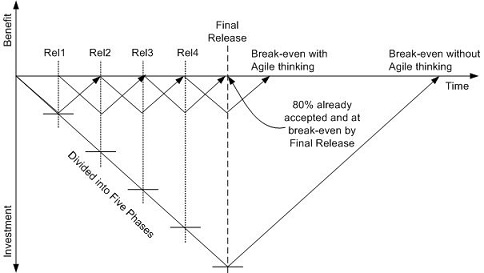Agile is a frequent topic in process improvement discussions and networking events alike – some going for Agile all the way and others rejecting it as something that won’t work for their projects or customers.
In general, I have found that a significant degree of value can be added to an organization’s software development process and bottom-line through the application of the expressed intentions of the Agile approach.
Consider:
Principles behind the Agile Manifesto
We follow these principles:
Our highest priority is to satisfy the customer
through early and continuous delivery
of valuable software.
…
http://agilemanifesto.org/principles.html
If one understands Agile as not a methodology or process but as a philosophical approach to trying to do better at something that has traditionally not worked as well as it could, substantial opportunity exists for improvement:
“This year’s results show a marked decrease in project success rates, with 32% of all projects succeeding which are delivered on time, on budget, with required features and functions, 44% were challenged which are late, over budget, and/or with less than the required features and functions and 24% failed which are cancelled prior to completion or delivered and never used.”, Jim Johnson, chairman of The Standish Group, CHAOS Summary 2009 – http://standishgroup.com/newsroom/chaos_2009.php
This is not to say that using Agile will overcome all the challenges inherent in your development methodology, but rather that using each of the principles included in the Agile Manifesto to change your approach to planning and executing projects can get you significant “Quick Wins”.
For example with the principle: “…satisfy the customer through early and continuous delivery of valuable software”:
- Organize your project with 5 or more ‘releases’ to the customer for acceptance, rather than just the typical final release at the end.
- Distribute your effort and functionality evenly across the releases being sure to be able to show useful, increasing value with each release.
- Have the customer sign-off on each release and ideally start using it in their business activities in order to start realizing the benefits of the investment as soon as possible.
This approach can bring all sorts of benefits in terms of lowering the Total Cost of Quality, but the one key performance indicator we shall make an observation on is the aspect of customer satisfaction.

By the time the Final Release is given to the customer for acceptance, the business should have already accepted and be ramped up on the previous releases. Therefore the project team already has an 80% acceptance rating going into this last cycle.
It may be a little light-hearted to look at this outcome as similar to entering the final exam with an “A” already guaranteed, but fundamentally the team has reached the end of the project proving with each release that they are in synch with the customer’s needs and are delivering the solution that fits that need.
Good grades aren’t everything when looking for a successful project, but without a happy customer…



